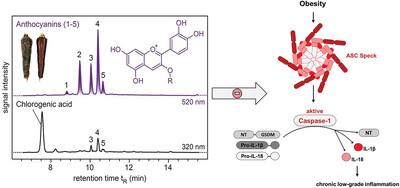当前位置:
X-MOL 学术
›
Mol. Nutr. Food Res.
›
论文详情
Our official English website, www.x-mol.net, welcomes your
feedback! (Note: you will need to create a separate account there.)
Acylated Anthocyanins From Black Carrots and Their Related Phenolic Acids Diminish Priming and Activation of the NLRP3 Inflammasome in THP-1 Monocytes
Molecular Nutrition & Food Research ( IF 4.5 ) Pub Date : 2024-10-19 , DOI: 10.1002/mnfr.202400356 Inken Behrendt, Katharina Becker, Christof Björn Steingass, Ralf Schweiggert, Gabriela Michel, Elvira Friedrich, Daniela Grote, Zoe Martin, Hanna Pauline Dötzer, Mathias Fasshauer, Martin Speckmann, Sabine Kuntz
Molecular Nutrition & Food Research ( IF 4.5 ) Pub Date : 2024-10-19 , DOI: 10.1002/mnfr.202400356 Inken Behrendt, Katharina Becker, Christof Björn Steingass, Ralf Schweiggert, Gabriela Michel, Elvira Friedrich, Daniela Grote, Zoe Martin, Hanna Pauline Dötzer, Mathias Fasshauer, Martin Speckmann, Sabine Kuntz

|
Excessive activation of the nucleotide-binding oligomerization domain-like receptor pyrin domain-containing protein 3 (NLRP3) inflammasome contributes to chronic inflammation. Thus, targeting NLRP3 inflammasome activation by anthocyanins may prevent inflammatory diseases. Therefore, the present study determines the influence of a black carrot extract (BCE) with high amounts of acylated anthocyanins and their related phenolic acids on the NLRP3 inflammasome.
中文翻译:

来自黑胡萝卜的酰化花青素及其相关的酚酸会减少 THP-1 单核细胞中 NLRP3 炎性小体的启动和激活
核苷酸结合寡聚结构域样受体 pyrin 结构域包含蛋白结构域的蛋白 3 (NLRP3) 炎性小体的过度激活会导致慢性炎症。因此,通过花青素靶向 NLRP3 炎性小体激活可以预防炎症性疾病。因此,本研究确定了含有大量酰化花青素及其相关酚酸的黑胡萝卜提取物 (BCE) 对 NLRP3 炎性小体的影响。
更新日期:2024-10-19
中文翻译:

来自黑胡萝卜的酰化花青素及其相关的酚酸会减少 THP-1 单核细胞中 NLRP3 炎性小体的启动和激活
核苷酸结合寡聚结构域样受体 pyrin 结构域包含蛋白结构域的蛋白 3 (NLRP3) 炎性小体的过度激活会导致慢性炎症。因此,通过花青素靶向 NLRP3 炎性小体激活可以预防炎症性疾病。因此,本研究确定了含有大量酰化花青素及其相关酚酸的黑胡萝卜提取物 (BCE) 对 NLRP3 炎性小体的影响。






























 京公网安备 11010802027423号
京公网安备 11010802027423号